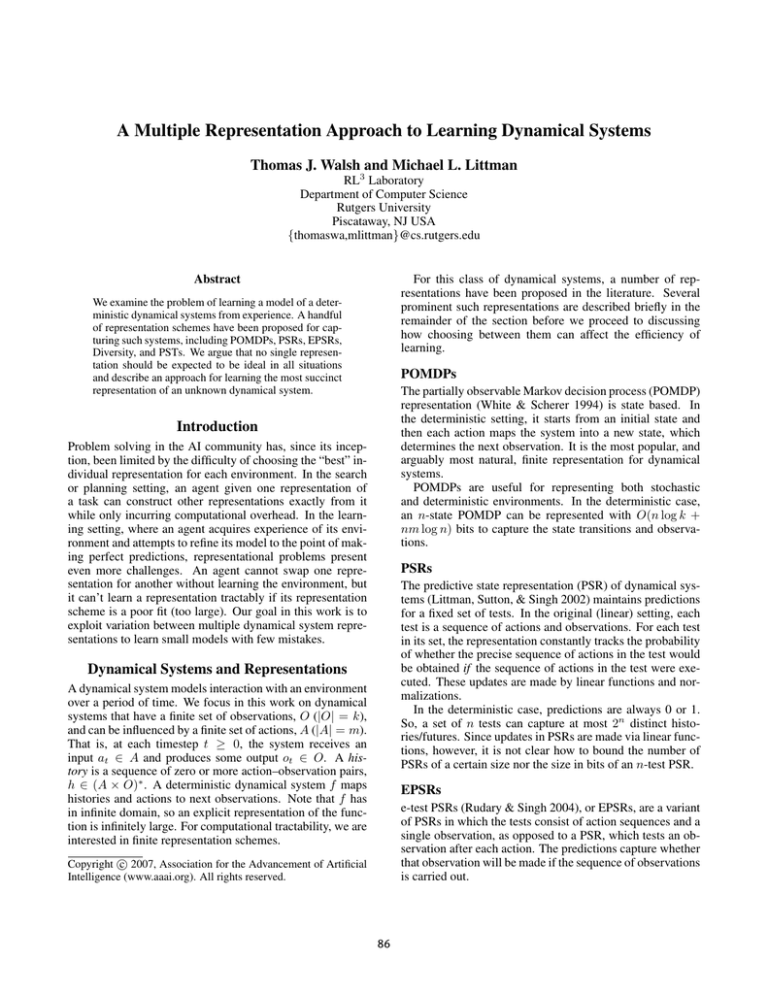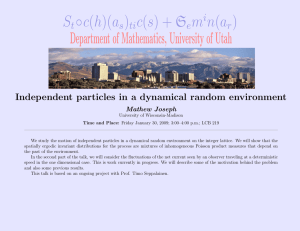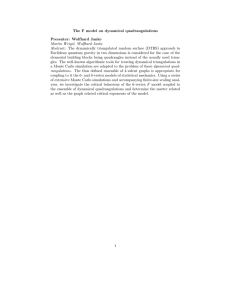
A Multiple Representation Approach to Learning Dynamical Systems
Thomas J. Walsh and Michael L. Littman
RL3 Laboratory
Department of Computer Science
Rutgers University
Piscataway, NJ USA
{thomaswa,mlittman}@cs.rutgers.edu
For this class of dynamical systems, a number of representations have been proposed in the literature. Several
prominent such representations are described briefly in the
remainder of the section before we proceed to discussing
how choosing between them can affect the efficiency of
learning.
Abstract
We examine the problem of learning a model of a deterministic dynamical systems from experience. A handful
of representation schemes have been proposed for capturing such systems, including POMDPs, PSRs, EPSRs,
Diversity, and PSTs. We argue that no single representation should be expected to be ideal in all situations
and describe an approach for learning the most succinct
representation of an unknown dynamical system.
POMDPs
The partially observable Markov decision process (POMDP)
representation (White & Scherer 1994) is state based. In
the deterministic setting, it starts from an initial state and
then each action maps the system into a new state, which
determines the next observation. It is the most popular, and
arguably most natural, finite representation for dynamical
systems.
POMDPs are useful for representing both stochastic
and deterministic environments. In the deterministic case,
an n-state POMDP can be represented with O(n log k +
nm log n) bits to capture the state transitions and observations.
Introduction
Problem solving in the AI community has, since its inception, been limited by the difficulty of choosing the “best” individual representation for each environment. In the search
or planning setting, an agent given one representation of
a task can construct other representations exactly from it
while only incurring computational overhead. In the learning setting, where an agent acquires experience of its environment and attempts to refine its model to the point of making perfect predictions, representational problems present
even more challenges. An agent cannot swap one representation for another without learning the environment, but
it can’t learn a representation tractably if its representation
scheme is a poor fit (too large). Our goal in this work is to
exploit variation between multiple dynamical system representations to learn small models with few mistakes.
PSRs
The predictive state representation (PSR) of dynamical systems (Littman, Sutton, & Singh 2002) maintains predictions
for a fixed set of tests. In the original (linear) setting, each
test is a sequence of actions and observations. For each test
in its set, the representation constantly tracks the probability
of whether the precise sequence of actions in the test would
be obtained if the sequence of actions in the test were executed. These updates are made by linear functions and normalizations.
In the deterministic case, predictions are always 0 or 1.
So, a set of n tests can capture at most 2n distinct histories/futures. Since updates in PSRs are made via linear functions, however, it is not clear how to bound the number of
PSRs of a certain size nor the size in bits of an n-test PSR.
Dynamical Systems and Representations
A dynamical system models interaction with an environment
over a period of time. We focus in this work on dynamical
systems that have a finite set of observations, O (|O| = k),
and can be influenced by a finite set of actions, A (|A| = m).
That is, at each timestep t ≥ 0, the system receives an
input at ∈ A and produces some output ot ∈ O. A history is a sequence of zero or more action–observation pairs,
h ∈ (A × O)∗ . A deterministic dynamical system f maps
histories and actions to next observations. Note that f has
in infinite domain, so an explicit representation of the function is infinitely large. For computational tractability, we are
interested in finite representation schemes.
EPSRs
e-test PSRs (Rudary & Singh 2004), or EPSRs, are a variant
of PSRs in which the tests consist of action sequences and a
single observation, as opposed to a PSR, which tests an observation after each action. The predictions capture whether
that observation will be made if the sequence of observations
is carried out.
c 2007, Association for the Advancement of Artificial
Copyright Intelligence (www.aaai.org). All rights reserved.
86
Diversity
in order of their size. That is, it considers all representations of size B, and if and only if all these models are invalidated through experience, moves on to representations of
size B +1. The “pure” representations (POMDPs, Diversity,
and PSTs) are the best matches for this approach. PSRs and
EPSRs can be enumerated, but because their update functions can include arbitrary numbers, some additional results
are needed to ensure a scheme that is sound and complete.
The approach is reminiscent of Levin search (Wiering &
Schmidhuber 1996) in that it considers representations in
size order. It also accomplishes the stated goal of learning with a small number of mistakes when compared to the
same basic search strategy restricted to a single representation. In the worst case, the multiple representations strategy
learns the correct model while making a number of prediction mistakes that is exponential in the size of the smallest
representation, which we have seen in the last section may
be exponentially smaller than some a priori chosen representation.
The Diversity representation (Rivest & Schapire 1989) can
be viewed as a variant of EPSRs in which the update matrices are captured by graphs. That is, after each action, each
test is updated by copying the prediction from some other
test. Like POMDPs, an n-test Diversity representation can
be written with O(n log k + nm log n) bits.
PSTs
Whereas PSRs, EPSRs, and Diversity are grounded in the
future, and POMDPs in the current state, looping suffix trees
(“predictive” suffix trees) or PSTs make predictions based
on past history (Holmes & Isbell 2006). That is, each branch
of the suffix tree maps a history sequence and action to the
next observation. The inclusion of the possibility of back
edges, or loops, in the suffix tree allows PSTs to condition
observation choices on actions or observations arbitrarily in
the past. A PST with n internal nodes and l leaves can be
represented with O(nmk log(n + l) + lm log k) bits.
Conclusion
Our exploration of dynamical system learning with multiple
representations is still in its preliminary stages, but the facts
reported above evince clear advantages over learning with
an a priori fixed representation. We are currently endeavoring to fill in several of the “gaps” in the size comparisons
concerning PSTs discussed above, and considering how to
integrate PSR and EPSR representations into the ensemble.
Overall, the approach seeks to leverage the parallel updating of models into an exponential speedup in the learning
process and the corresponding exponential reduction in mistakes made during learning.
Relationships Between Representations
Let D be the set of deterministic dynamical systems that
can be represented by a finite POMDP. We note, without
proof, that D is also precisely the set of deterministic dynamical systems that can be represented finitely by EPSRs,
by PSRs, by Diversity, and by PSTs. The fact that these definitions all coincide is not a trivial fact. Indeed, the same is
not true for non-looping suffix trees (Holmes & Isbell 2006)
or k-order Markov models (Littman, Sutton, & Singh 2002),
which represent finitely a proper subset of D.
Although the representations can capture the same environments finitely, they vary in the number of bits they
need to express them. For example, there are families of
dynamical systems that require exponentially larger Diversity representations than POMDPs and vice versa (Rivest
& Schapire 1989). However, these two representations are
never more than exponentially far apart in size (Rivest &
Schapire 1989). Similar minimal-size comparisons for EPSRs, POMDPs, PSRs and Diversity are also known (Rudary
& Singh 2004), and show that there are settings where
each of these representations may provide an exponentially
smaller model than the others.
No relative size bounds for PSTs have been published. We
have derived several relevant bounds. We can show a double
exponential upper bound on the size of a PST compared to
its size as a POMDP. We have also identified a dynamical
system consisting of relatively prime loops that requires an
exponentially larger representation as a PST compared to a
POMDP. We conjecture that the reverse can also be accomplished.
References
Holmes, M., and Isbell, C. 2006. Looping suffix tree-based
inference of partially observable hidden state. In Proceedings of the Twenty-Third International Conference on Machine Learning (ICML).
Littman, M. L.; Sutton, R. S.; and Singh, S. 2002. Predictive representations of state. In Advances in Neural Information Processing Systems 14, 1555–1561.
Rivest, R. L., and Schapire, R. E. 1989. Inference of finite
automata using homing sequences. In Proceedings of the
Twenty-First Annual ACM Symposium on Theory of Computing, 411–420.
Rudary, M. R., and Singh, S. 2004. A nonlinear predictive
state representation. In Advances in Neural Information
Processing Systems 16 (NIPS), 855–862.
White, III, C. C., and Scherer, W. T. 1994. Finite-memory
suboptimal design for partially observed Markov decision
processes. Operations Research 42(3):439–455.
Wiering, M., and Schmidhuber, J. 1996. Solving POMDPs
with Levin search and EIRA. In Machine Learning: Procceedings of 13th International Conference, 534–542.
Enumerative Search
We now consider a primitive learning algorithm that exploits
the lack of a general “best” representation by learning multiple representations of a given dynamical system. Our algorithm is a search procedure that enumerates representations
87





